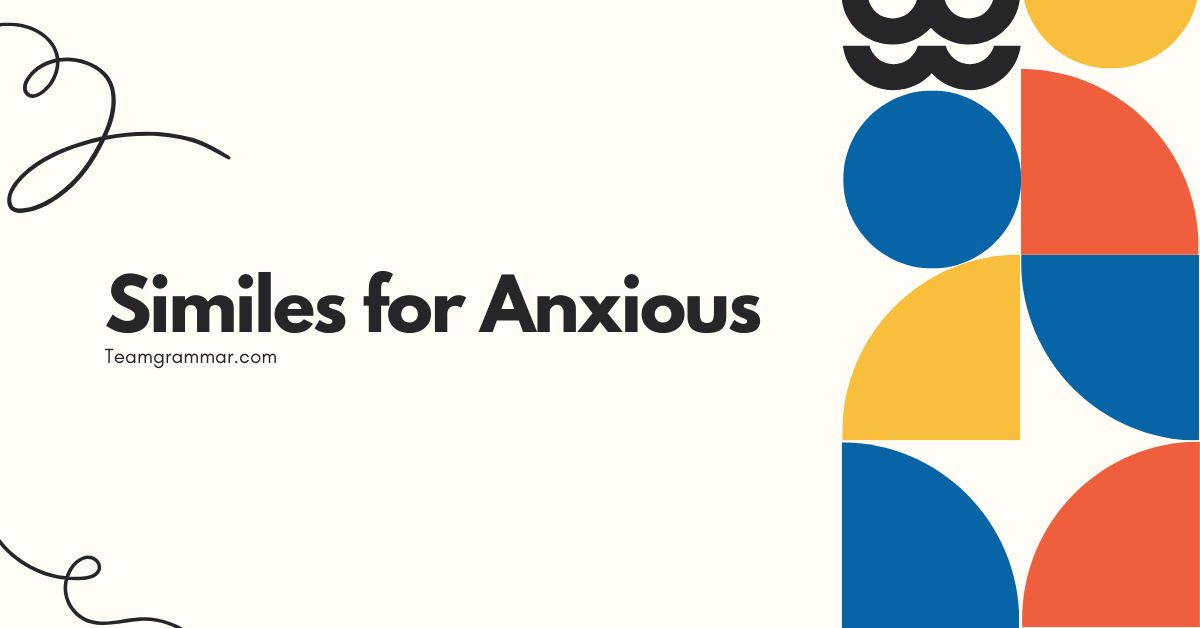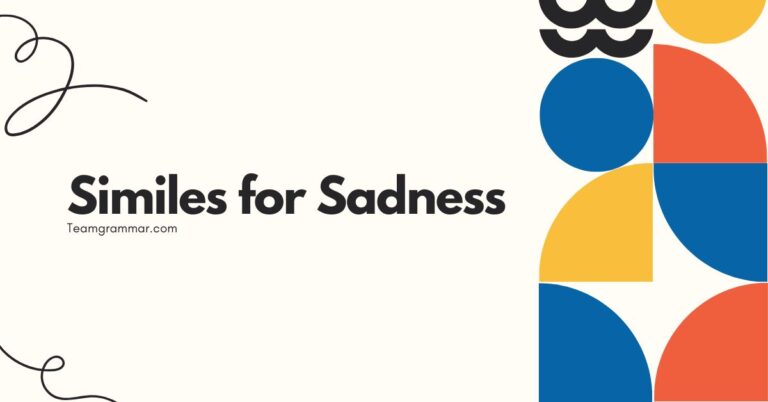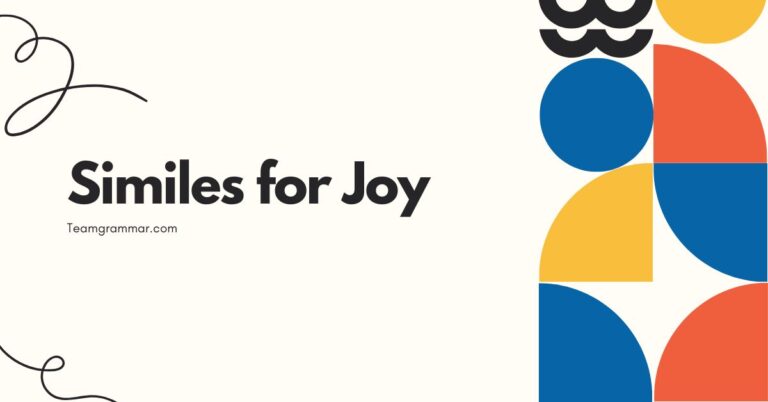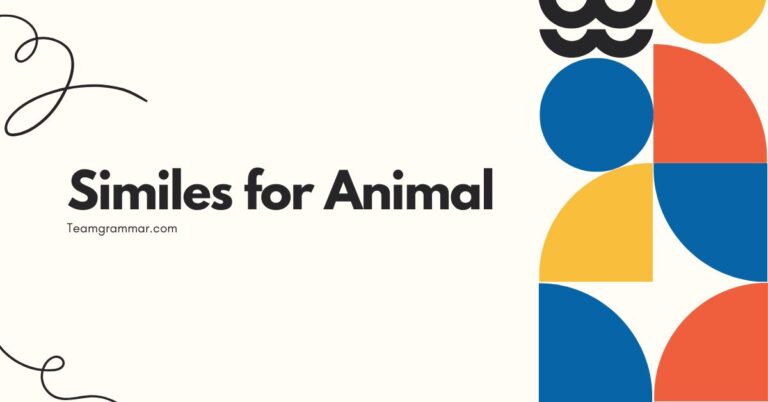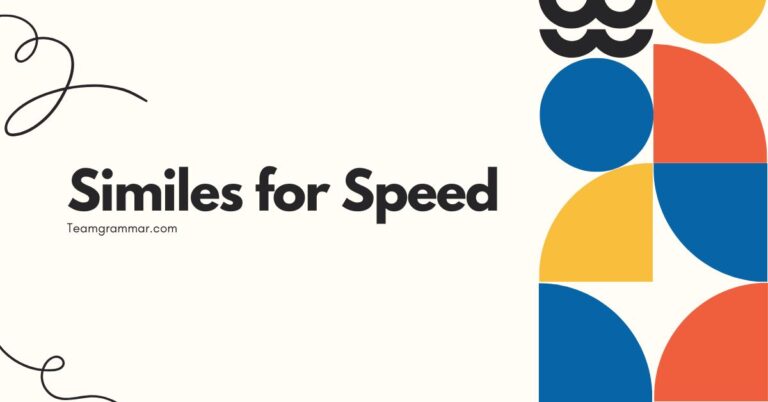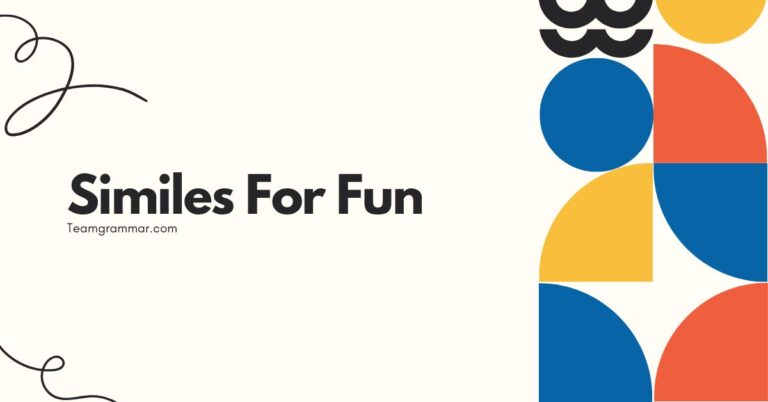37 Similes for Anxious: Mastering Figurative Language in English
Understanding similes is crucial for enriching your descriptive language and conveying emotions vividly. Similes, a key component of figurative language, enhance writing and speaking by creating comparisons between dissimilar things using “like” or “as.” This skill is particularly beneficial for expressing nuanced feelings such as anxiety.
This article provides a comprehensive guide to using similes to describe anxiety, offering examples, explanations, and practice exercises suitable for English learners of all levels, from beginners to advanced speakers seeking to refine their expressive capabilities.
Table of Contents
- Definition of Similes
- Structural Breakdown of Similes
- Types of Similes for Anxiety
- Examples of Similes for Anxious
- Usage Rules for Similes
- Common Mistakes with Similes
- Practice Exercises
- Advanced Topics: Nuances and Subtleties
- Frequently Asked Questions
- Conclusion
Definition of Similes
A simile is a figure of speech that compares two unlike things using the words “like” or “as.” The purpose of a simile is to create a vivid image or to emphasize a particular quality shared by the two things being compared. Similes are essential tools in descriptive writing and everyday conversation, allowing speakers and writers to express complex emotions and ideas in relatable ways.
In the context of expressing anxiety, similes can be particularly effective. Anxiety is an abstract emotion, and using similes allows us to ground this feeling in concrete, relatable experiences.
For example, saying “My heart was beating like a drum” is far more evocative than simply stating “I was anxious.” The simile provides a sensory detail that helps the listener or reader understand the intensity of the anxiety.
Similes fall under the broader category of figurative language, which includes metaphors, personification, and hyperbole. Unlike metaphors, which directly equate two things (e.g., “He is a lion”), similes make a comparison using “like” or “as” (e.g., “He is brave like a lion”).
This distinction is crucial in understanding how similes function to create comparisons without asserting direct equivalence.
Function of Similes
The primary function of similes is to enhance understanding and create vivid imagery. By comparing an abstract concept like anxiety to something concrete and familiar, similes make the feeling more accessible to the audience.
For instance, comparing anxiety to “walking on eggshells” immediately conveys a sense of fragility and tension.
Similes also serve to emphasize specific qualities or characteristics. When we say someone is “as quiet as a mouse,” we are not simply stating that they are quiet; we are highlighting the degree of their quietness and perhaps even suggesting a sense of timidity or unobtrusiveness.
In the context of anxiety, a simile like “My thoughts raced like a runaway train” emphasizes the speed and uncontrollability of anxious thoughts.
Contexts for Using Similes
Similes are appropriate in a wide range of contexts, from formal writing to casual conversation. In literature, similes are frequently used to enrich descriptions and develop characters.
In everyday speech, similes can add color and expressiveness to our communication. However, it’s important to consider the audience and the purpose of the communication when choosing a simile.
For example, a highly technical or academic context might not be the best place for overly elaborate or poetic similes. Conversely, a creative writing piece or a personal narrative would benefit from the strategic use of similes to enhance the emotional impact.
When discussing anxiety, using similes can help others empathize with the experience and understand the intensity of the feeling.
Structural Breakdown of Similes
Similes follow a basic structural pattern that involves two key components: the subject being described and the object or idea to which it is being compared. These two elements are connected by the words “like” or “as.” Understanding this structure is essential for creating effective and meaningful similes.
The structure of a simile can be represented as follows: Subject + “like” or “as” + Object of Comparison. For example, in the simile “My anxiety felt like a heavy weight,” “My anxiety” is the subject, “like” is the connecting word, and “a heavy weight” is the object of comparison.
This structure clearly establishes the comparison being made.
The Role of “Like” and “As”
The words “like” and “as” are the linchpins of a simile. They indicate that a comparison is being made, rather than a direct equivalence.
While both words serve the same basic function, there are subtle differences in their usage. “Like” is often used to compare nouns or pronouns, while “as” can be used to compare clauses or phrases.
For example:
- “She felt like she was drowning.” (comparing a feeling to drowning)
- “He was as still as a statue.” (comparing a person to a statue)
The choice between “like” and “as” often depends on the specific context and the desired emphasis.
Identifying the Subject and Object
Identifying the subject and object of comparison is crucial for understanding and creating similes. The subject is the thing being described, while the object is the thing to which it is being compared.
In the context of anxiety, the subject is often the feeling of anxiety itself or the person experiencing it.
For example, in the simile “His palms were as sweaty as ice,” the subject is “His palms,” and the object of comparison is “ice.” This simile conveys the idea that his palms were not just sweaty, but also cold, which is a common physical manifestation of anxiety.
Types of Similes for Anxiety
Similes for anxiety can be categorized based on the type of comparison they make. These categories include physical sensations, emotional states, and behavioral patterns.
Understanding these categories can help you choose the most appropriate simile to express a particular aspect of anxiety.
Physical Sensations
Anxiety often manifests in physical symptoms, such as a racing heart, shortness of breath, or sweating. Similes that focus on these physical sensations can effectively convey the bodily experience of anxiety.
Examples include:
- “My heart was pounding like a drum.”
- “My breath felt as shallow as a puddle.”
- “My hands were as clammy as a fish.”
Emotional States
Anxiety is also characterized by specific emotional states, such as fear, worry, and unease. Similes that compare anxiety to these emotional states can highlight the psychological impact of the feeling.
Examples include:
- “I felt like I was walking on eggshells.”
- “My mind was as restless as a stormy sea.”
- “I felt as vulnerable as a newborn.”
Behavioral Patterns
Anxiety can also influence behavior, leading to actions such as pacing, fidgeting, or avoiding certain situations. Similes that describe these behavioral patterns can illustrate how anxiety affects a person’s actions.
Examples include:
- “I was pacing like a caged animal.”
- “I was fidgeting like a child waiting for a treat.”
- “I felt as trapped as a bird in a cage.”
Examples of Similes for Anxious
This section provides a comprehensive collection of similes that can be used to describe anxiety. These examples are organized into tables to facilitate understanding and comparison.
Each table focuses on a specific aspect of anxiety, such as physical sensations, emotional states, or behavioral patterns.
The following table provides examples of similes that describe the physical sensations associated with anxiety. These similes focus on bodily experiences such as heart rate, breathing, and muscle tension.
| Simile | Explanation |
|---|---|
| My heart was racing like a hummingbird’s wings. | Emphasizes the rapid and erratic heartbeat associated with anxiety. |
| My breath was as shallow as a whisper. | Highlights the difficulty in breathing deeply. |
| My muscles were as tight as a coiled spring. | Describes the physical tension and rigidity caused by anxiety. |
| My stomach felt like it was tied in knots. | Conveys the feeling of nausea or discomfort in the stomach. |
| My hands were as clammy as a cold fish. | Illustrates the sweaty and cold sensation in the hands. |
| My head felt like it was in a vise. | Describes the sensation of a headache or pressure in the head. |
| My legs felt like lead. | Highlights the feeling of heaviness and difficulty in moving. |
| My voice was as shaky as a leaf in the wind. | Conveys the trembling and unsteady voice caused by nervousness. |
| My skin felt like it was crawling with ants. | Describes the sensation of tingling or itching on the skin. |
| My vision was as blurry as looking through a fog. | Illustrates the distorted or unclear vision caused by anxiety. |
| My throat felt as dry as the desert. | Highlights the sensation of dryness and difficulty in swallowing. |
| My pulse was throbbing like a drum solo. | Emphasizes the strong and rhythmic pulse associated with anxiety. |
| My sweat was pouring like a waterfall. | Describes the excessive sweating caused by nervousness. |
| My body was trembling like an earthquake. | Conveys the intense shaking and instability caused by anxiety. |
| My teeth were chattering like castanets. | Illustrates the involuntary teeth chattering due to fear. |
| My face was as flushed as a tomato. | Highlights the redness and warmth in the face caused by anxiety. |
| My senses were as heightened as a predator’s. | Illustrates the hyper-awareness and alertness that can come with anxiety. |
| My energy was draining like a leaky faucet. | Conveys the feeling of exhaustion and depletion caused by anxiety. |
| My nerves were as raw as an open wound. | Describes the extreme sensitivity and vulnerability caused by anxiety. |
| My breathing was as ragged as a torn sail. | Highlights the uneven and labored breathing associated with panic. |
The following table provides examples of similes that describe the emotional states associated with anxiety. These similes focus on feelings such as fear, worry, and unease.
| Simile | Explanation |
|---|---|
| I felt like I was walking on eggshells. | Conveys the feeling of being constantly on guard and afraid of making a mistake. |
| My mind was as restless as a stormy sea. | Highlights the constant and turbulent thoughts associated with anxiety. |
| I felt as vulnerable as a newborn. | Describes the feeling of being exposed and unprotected. |
| My worries were multiplying like rabbits. | Emphasizes the rapid and uncontrollable increase in anxious thoughts. |
| I felt like I was drowning in a sea of worries. | Conveys the overwhelming and suffocating feeling of anxiety. |
| My fears were as dark as a moonless night. | Illustrates the intense and pervasive nature of anxious thoughts. |
| I felt like I was trapped in a never-ending nightmare. | Describes the feeling of being stuck in a cycle of fear and dread. |
| My anxiety was as heavy as a lead blanket. | Highlights the oppressive and burdensome nature of anxious feelings. |
| I felt like I was carrying the weight of the world on my shoulders. | Conveys the immense pressure and responsibility felt during anxiety. |
| My thoughts were racing like a runaway train. | Emphasizes the speed and uncontrollability of anxious thoughts. |
| I felt as helpless as a child lost in a crowd. | Describes the feeling of being overwhelmed and unable to cope. |
| My anxiety was as sharp as a knife. | Highlights the intense and piercing nature of anxious feelings. |
| I felt like I was walking through a minefield. | Conveys the constant fear of impending disaster or negative consequences. |
| My worries were as persistent as a dripping faucet. | Emphasizes the constant and irritating nature of anxious thoughts. |
| I felt like I was being watched by a thousand eyes. | Describes the feeling of paranoia and heightened self-consciousness. |
| My anxiety was as suffocating as a closed room. | Highlights the feeling of being trapped and unable to escape. |
| I felt like I was living in a constant state of alert. | Illustrates the hypervigilance and readiness for danger that can accompany anxiety. |
| My emotions were as volatile as nitroglycerin. | Conveys the feeling of being on the verge of an emotional explosion. |
| My self-doubt was growing like a weed. | Describes the pervasive and destructive nature of negative self-talk. |
| My sense of control was slipping away like sand through my fingers. | Highlights the feeling of losing control and being overwhelmed by anxiety. |
The following table provides examples of similes that describe the behavioral patterns associated with anxiety. These similes focus on actions such as pacing, fidgeting, and avoidance.
| Simile | Explanation |
|---|---|
| I was pacing like a caged animal. | Conveys the restless and agitated behavior caused by anxiety. |
| I was fidgeting like a child waiting for a treat. | Highlights the nervous and restless movements caused by anxiety. |
| I felt as trapped as a bird in a cage. | Describes the feeling of being confined and unable to escape. |
| I was avoiding eye contact like the plague. | Emphasizes the desire to avoid social interaction due to anxiety. |
| I was biting my nails like a nervous habit. | Illustrates the repetitive and unconscious behaviors caused by anxiety. |
| I was checking the locks like a security guard. | Highlights the compulsive behaviors caused by anxiety. |
| I was rehearsing the conversation like an actor preparing for a role. | Conveys the need to plan and control social interactions due to anxiety. |
| I was overthinking every detail like a detective solving a crime. | Emphasizes the tendency to analyze and scrutinize every aspect of a situation. |
| I was isolating myself like a hermit. | Highlights the desire to withdraw from social contact due to anxiety. |
| I was procrastinating like a professional. | Conveys the tendency to avoid tasks and responsibilities due to anxiety. |
| I was seeking reassurance like a lost child. | Emphasizes the need for validation and support due to anxiety. |
| I was seeking distractions like an addict. | Highlights the desire to escape from anxious thoughts and feelings. |
| I was clinging to routine like a lifeline. | Conveys the need for structure and predictability to manage anxiety. |
| I was scrutinizing my body like a doctor examining a patient. | Emphasizes the hyper-awareness of physical sensations due to anxiety. |
| I was planning escape routes like a prisoner. | Highlights the need to feel in control and prepared for potential threats. |
| I was second-guessing myself like a rookie. | Conveys the lack of confidence and self-doubt caused by anxiety. |
| I was monitoring my surroundings like a hawk. | Illustrates the hyper-awareness and vigilance caused by anxiety. |
| I was holding my breath like I was underwater. | Conveys the feeling of being stifled and unable to breathe freely. |
| I was jumping at shadows like a scared cat. | Highlights the exaggerated startle response caused by anxiety. |
| I was speaking in circles like a politician. | Conveys the difficulty in communicating clearly due to anxiety. |
Usage Rules for Similes
Using similes effectively requires an understanding of the rules that govern their proper use. These rules include ensuring that the comparison is logical and meaningful, avoiding clichés, and considering the audience and context.
Ensuring Logical Comparisons
The most important rule for using similes is to ensure that the comparison is logical and meaningful. The two things being compared should share a common characteristic or quality that is relevant to the description.
If the comparison is illogical or nonsensical, the simile will be ineffective and may even confuse the audience.
For example, the simile “My anxiety was as tall as a building” is not particularly effective because anxiety is an emotion, and buildings are physical structures. While it attempts to convey the magnitude of the anxiety, the comparison lacks a clear and logical connection.
Avoiding Clichés
Clichés are overused phrases that have lost their impact due to frequent use. Similes are particularly prone to becoming clichés, such as “as busy as a bee” or “as quiet as a mouse.” While these similes are grammatically correct, they lack originality and fail to create a vivid image.
To avoid clichés, strive to create fresh and unique comparisons.
Instead of saying “My heart was beating like a drum,” which is a common cliché, you could say “My heart was pounding like a jackhammer,” which is a more original and evocative comparison.
Considering Audience and Context
The effectiveness of a simile depends on the audience and context in which it is used. A simile that is appropriate in one situation may be inappropriate in another.
For example, a highly technical or academic context may not be the best place for overly poetic or figurative language. Conversely, a creative writing piece or personal narrative would benefit from the strategic use of similes to enhance the emotional impact.
When discussing anxiety, it’s important to choose similes that are relatable and understandable to the audience. If you are speaking to someone who has never experienced anxiety, you may need to use simpler and more concrete comparisons to help them understand the feeling.
Common Mistakes with Similes
Even experienced writers and speakers sometimes make mistakes when using similes. These mistakes include confusing similes with metaphors, using illogical comparisons, and creating mixed metaphors.
Being aware of these common errors can help you avoid them in your own writing and speaking.
Confusing Similes with Metaphors
One of the most common mistakes is confusing similes with metaphors. While both are figures of speech that make comparisons, they do so in different ways.
Similes use the words “like” or “as” to make a comparison, while metaphors directly equate two things without using these words.
Incorrect (Metaphor): My anxiety was a storm.
Correct (Simile): My anxiety was like a storm.
Using Illogical Comparisons
Another common mistake is using illogical comparisons that do not make sense. The two things being compared should share a common characteristic or quality that is relevant to the description.
If the comparison is illogical, the simile will be ineffective and may even confuse the audience.
Incorrect: My anxiety was as purple as a grape.
Correct: My anxiety was as heavy as a ton of bricks.
Creating Mixed Metaphors
Mixed metaphors occur when two or more metaphors or similes are combined in a way that creates a nonsensical or contradictory image. This can happen when the writer or speaker loses track of the original comparison and introduces another comparison that clashes with it.
Incorrect: The ship of state is navigating through a sea of troubles, and we must iron out all the wrinkles. (Mixing nautical and ironing metaphors)
Correct: The ship of state is navigating through a sea of troubles, and we must steer it towards calmer waters.
Practice Exercises
This section provides practice exercises to help you improve your ability to use similes to describe anxiety. These exercises include identifying similes, completing similes, and creating your own similes.
Exercise 1: Identify the Similes
Identify the similes in the following sentences. Underline the simile and identify the two things being compared.
| Question | Answer |
|---|---|
| 1. My heart was pounding like a drum. | My heart was pounding like a drum. Heart pounding compared to a drum. |
| 2. I felt like I was walking on eggshells. | I felt like I was walking on eggshells. Feeling compared to walking on eggshells. |
| 3. My mind was as restless as a stormy sea. | My mind was as restless as a stormy sea. Mind compared to a stormy sea. |
| 4. My anxiety was as heavy as a lead blanket. | My anxiety was as heavy as a lead blanket. Anxiety compared to a lead blanket. |
| 5. I felt as trapped as a bird in a cage. | I felt as trapped as a bird in a cage. Feeling compared to a bird in a cage. |
| 6. His face was as red as a beet. | His face was as red as a beet. Face compared to a beet. |
| 7. She was as quiet as a mouse. | She was as quiet as a mouse. She compared to a mouse. |
| 8. The news hit him like a ton of bricks. | The news hit him like a ton of bricks. News compared to a ton of bricks. |
| 9. My hands were as cold as ice. | My hands were as cold as ice. Hands compared to ice. |
| 10. He eats like a horse. | He eats like a horse. He compared to a horse. |
Exercise 2: Complete the Similes
Complete the following similes by filling in the blank with an appropriate word or phrase.
| Question | Answer |
|---|---|
| 1. My anxiety felt like ____________. | My anxiety felt like a heavy weight. |
| 2. My thoughts were racing like ____________. | My thoughts were racing like a runaway train. |
| 3. I felt as vulnerable as ____________. | I felt as vulnerable as a newborn. |
| 4. My worries were multiplying like ____________. | My worries were multiplying like rabbits. |
| 5. My breath was as shallow as ____________. | My breath was as shallow as a whisper. |
| 6. He was shaking like ____________. | He was shaking like a leaf in the wind. |
| 7. My stomach felt like ____________. | My stomach felt like it was tied in knots. |
| 8. The silence was deafening like ____________. | The silence was deafening like a sudden explosion. |
| 9. Her smile was as bright as ____________. | Her smile was as bright as the sun. |
| 10. The task ahead felt as daunting as ____________. | The task ahead felt as daunting as climbing Mount Everest. |
Exercise 3: Create Your Own Similes
Create your own similes to describe the following aspects of anxiety.
| Aspect of Anxiety | Example Simile |
|---|---|
| 1. The feeling of being overwhelmed | I felt like I was drowning in a sea of responsibilities. |
| 2. The sensation of a racing heart | My heart was pounding like a jackhammer. |
| 3. The experience of difficulty breathing | My breath felt as shallow as sipping air through a straw. |
| 4. The sensation of muscle tension | My muscles were as tight as guitar strings. |
| 5. The feeling of unease | I felt like I was walking through a haunted house. |
| 6. The sensation of sweaty palms | My palms were as slippery as a wet bar of soap. |
| 7. The feeling of being trapped | I felt like I was stuck in quicksand, unable to move. |
| 8. The experience of constant worry | My worries were like a swarm of mosquitos, constantly buzzing around. |
| 9. The sensation of a dry throat | My throat was as parched as the Sahara Desert. |
| 10. The feeling of panic | I felt like I was freefalling from a skyscraper. |
Advanced Topics: Nuances and Subtleties
For advanced learners, understanding the nuances and subtleties of similes can further enhance their expressive capabilities. This includes exploring the use of extended similes, understanding the impact of different word choices, and considering the cultural context in which similes are used.
Extended Similes
An extended simile is a simile that is developed over several sentences or even paragraphs. Instead of simply stating a comparison, the writer elaborates on the similarities between the two things being compared, creating a more detailed and vivid image.
For example: “My anxiety was like a storm, starting as a distant rumble of unease, gradually building into a torrent of worry, and finally erupting into a full-blown tempest of panic. The wind of fear whipped through my thoughts, the rain of tears streamed down my face, and the thunder of my heart pounded in my chest.”
Impact of Word Choice
The specific words used in a simile can have a significant impact on its effectiveness. Choosing strong and evocative words can create a more vivid and memorable image.
Consider the connotations and associations of the words you use, and choose words that are appropriate for the context and audience.
For example, instead of saying “My anxiety was as big as a house,” you could say “My anxiety was as vast as an ocean,” which is a more evocative and impactful comparison.
Cultural Context
The meaning and interpretation of similes can vary depending on the cultural context in which they are used. A simile that is familiar and understandable in one culture may be confusing or offensive in another.
It’s important to be aware of these cultural differences and to choose similes that are appropriate for the audience.
For example, a simile that references a specific animal or plant may not be understandable to someone who is not familiar with that animal or plant. Similarly, a simile that references a historical event or cultural tradition may not be appropriate for an audience that is not familiar with that event or tradition.
Frequently Asked Questions
This section addresses some frequently asked questions about using similes to describe anxiety.
- What is the difference between a simile and a metaphor?
A simile compares two unlike things using “like” or “as,” while a metaphor directly equates them without using these words. For example, “My anxiety is like a storm” (simile) versus “My anxiety is a storm” (metaphor).
- How can I avoid using clichés in my similes?
To avoid clichés, strive to create fresh and unique comparisons. Think about the specific qualities you want to emphasize and brainstorm original ways to express them. Consult a thesaurus to find alternative words and phrases.
- Is it okay to use similes in formal writing?
Yes, similes can be used in formal writing, but it’s important to use them judiciously and to choose similes that are appropriate for the context and audience. Avoid overly poetic or figurative language in highly technical or academic contexts.
- How can I make my similes more vivid and impactful?
To make your similes more vivid and impactful, use strong and evocative words, elaborate on the similarities between the two things being compared, and consider the connotations and associations of the words you use.
- What are some common mistakes to avoid when using similes?
Common mistakes include confusing similes with metaphors, using illogical comparisons, and creating mixed metaphors. Be aware of these errors and take steps to avoid them in your own writing and speaking.
- Can similes be used to describe other emotions besides anxiety?
Yes, similes can be used to describe a wide range of emotions, including happiness, sadness, anger, and fear. The key is to choose similes that are appropriate for the specific emotion you want to express.
- How do I choose the right simile for a particular situation?
Consider the audience, context, and purpose of your communication. Choose similes that are relatable, understandable, and appropriate for the situation. If you are unsure, it’s often best to err on the side of simplicity and clarity.
- Are there any cultural considerations when using similes?
Yes, the meaning and interpretation of similes can vary depending on the cultural context in which they are used. A simile that is familiar and understandable in one culture may be confusing or offensive in another. Be aware of these cultural differences and choose similes that are appropriate for the audience.
- How can I practice using similes more effectively?
Practice writing and speaking using similes on a regular basis. Experiment with different comparisons and word choices. Ask for feedback from others and pay attention to how similes are used in the writing and speaking of others.
- What if I can’t think of a good simile?
Don’t worry if you can’t think of a good simile right away. Take some time to brainstorm ideas and consider different ways to express the feeling or idea you want to convey. Consult a thesaurus or dictionary for inspiration. Sometimes, the best similes come from unexpected places.
Conclusion
Mastering the art of using similes to describe anxiety can significantly enhance your ability to communicate effectively and empathetically. By understanding the structure, types, and usage rules of similes, and by avoiding common mistakes, you can create vivid and impactful descriptions that resonate with your audience.
Remember to practice regularly, experiment with different comparisons, and consider the cultural context in which you are communicating.
Similes are a powerful tool for expressing complex emotions and ideas in a relatable way. By using similes to describe anxiety, you can help others understand and empathize with the experience, fostering greater connection and understanding.
Keep practicing, keep experimenting, and keep exploring the endless possibilities of figurative language.

